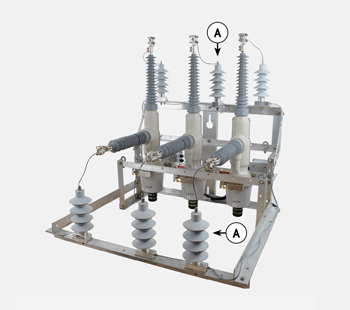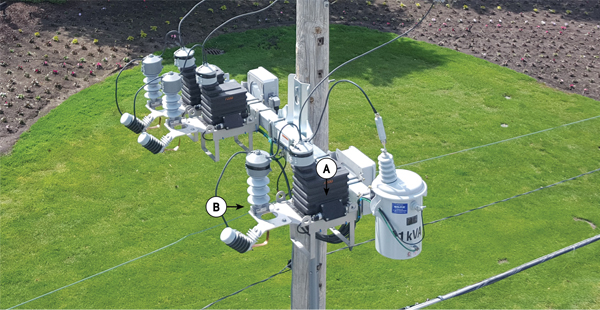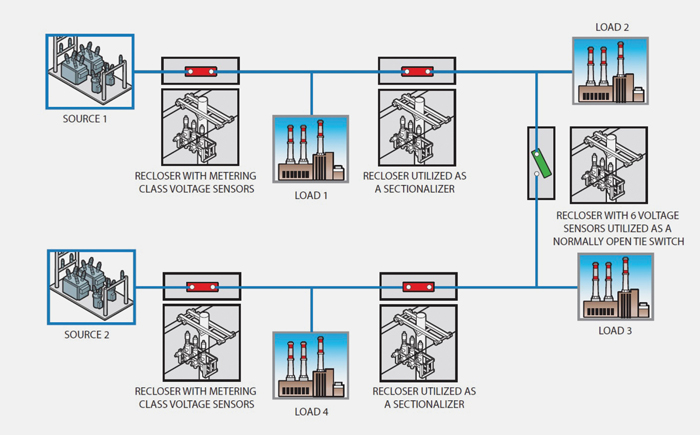For more than 100 years, power grids have fueled growth in the U.S., enabling numerous technology revolutions. Today, power grids across the country are being challenged to keep up with the demands of the 21st century. By 2030, our nation’s energy usage is expected to grow 30 percent, according to the Energy Information Administration. Our aging infrastructure, combined with the growth of distributed energy resources (DERs), is more prone to power outages and incurring electrical disturbances that affect power quality. These factors have a significant impact on the ability to provide a sustainable and reliable grid for the future.
To keep up with today’s demands and the future growth of the grid, our aging infrastructure will need to be modernized to optimize power delivery and reliability. Smart grid components in the distribution network such as reclosers, sensors, distribution automation and Supervisory Control and Data Acquisition (SCADA) communications can provide utilities with the tools needed to address these challenges, providing grid resiliency and reliable power to their consumers.
Electricity on Demand
Utilities across the U.S. have been installing smart grid devices at a record growth rate and are being challenged to utilize these assets to complement their smart grid strategy. The utilization of reclosers aligns with this strategy, providing more reliable power throughout the distribution network, thus improving reliability indices such as SAIDI and CAIDI. Traditionally, reclosers have been used to automatically restore power when temporary faults occur. Today, utilities have been further leveraging reclosers by implementing distribution automation schemes and increasing deployment based on a number of customers, a specified distance of distribution line and a specified amount of generated power from DERs. These strategies have proven to further optimize grid resiliency and reliability.
The question remains: how can assets in the distribution system be further optimized to complement strategic initiatives, such as improving grid efficiency and power quality? Initiatives such as volt-var optimization (VVO) and conservation voltage reduction (CVR) have proven to improve grid efficiency by reducing peak demand, distribution line losses and carbon emissions. Smart grid sensors, such as metering class voltage sensors, are an essential tool in providing the data needed for these programs and enable utilities to make critical decisions and adjustments to the grid. Installing metering class voltage sensors on a recloser can continue to leverage the capability of the recloser by serving as a metering point. A recloser used as a metering point serves as a dual-purpose protection and metering device designed to improve two common initiatives: improving system reliability and improving grid efficiency.
Reliable Reclosers & Sensors that Improve Grid Efficiency
With smart grid initiatives, the growth of DERs and the drive to maximize visibility on the grid, there is a growing need for utilities to maximize reliability, resiliency and power efficiency. Some utilities are deploying more reclosers to maximize reliability in the grid. One common methodology has been installing reclosers based on number of customers. A traditional method utilized one recloser installed for every 1,800-2,000 customers. Today, many utilities have analyzed system performance with the benefits of new smart grid technology and determined that one recloser for every 400-500 significantly improves grid reliability. Additionally, utilities have determined a strategy around deploying one recloser for a specified distance, such as three – to – four miles, or for a specified amount of generated power from DERs, such as 2-3MW when deployment of DERs is applicable. Implementing the combination of these strategies maximizes grid reliability.
The number of DERs is expected to double in the next five years, driving more inverters and potential power quality issues that are of interest to monitor to maintain grid stability and efficiency. Power quality issues that should be considered in DER applications are high orders of harmonics and harmonic distortion. These can cause undesirable effects on the grid such as increased transformer, capacitor, motor or generator heating, misoperation of electronic equipment such as protective relays and incorrect readings on meters. DERs, such as solar farms, can be configured with an intertie switch that will enable switching between the solar farm and utility sources. In these intertie applications, highly accurate sensors can be utilized to monitor power quality coming from DERs, such as harmonics, and provide utilities with system information that can support making important decisions.
Power quality can further be addressed with the implementation of VVO and CVR, which are proven methods to address the health and efficiency of the energy on the system. VVO can assist in improving power quality by providing accurate voltage and current data for utilities to make decisions such as switching capacitor banks. CVR promotes energy conservation by reducing voltage, which displaces costly grid generation. When voltage is reduced during peak load periods, there is a resulting reduction in peak demand. The voltage reduction equates to fewer line losses and more efficient use of energy. Additionally, when there is less demand for generation, less coal is burned, resulting in a reduction in carbon emissions. To comply with the requirements needed to execute these power quality initiatives, utilities seek to achieve voltage sensing measurements in real time that have a less than one percent error with an expectation of 0.5 percent error tolerance.
Compared to traditional voltage transformers used for metering class voltage accuracy, today’s voltage metering sensors are lightweight at less than 10lbs, utilize low energy inputs that are less than 10VAC for linemen safety, have higher basic impulse level (BIL) ratings, require no calibration and are easy to install. There are several voltage sensor solutions on the market; however, very few are 0.5 metering class accuracy (0.5 percent voltage accuracy) while being tested to industry standards. Additionally, these voltage sensors are typically sourced for the end user to integrate directly into the distribution system or onto a device in the system (i.e., such as a capacitor bank or recloser), rather than coming configured as a plug-and-play, pre-packaged solution.
When packaging high accuracy voltage sensors with a recloser into one pre-packaged device, it can be utilized to execute VVO & CVR programs while also serving as a versatile recloser. SCADA-enabled devices require communications equipment that needs to be commissioned, involving engineering and operator time and associated expenses. When devices such as reclosers and metering points are consolidated into one device, these SCADA commissioning expenses are cut in half. Additionally, many utilities value receiving a complete integrated system with pre-installed accessories and wiring from a single supplier, as opposed to sourcing and integrating all of the components together themselves. This packaged solution adds convenience and reduces the labor time and expense associated with installing capital equipment into the distribution system.
Recloser Pre-Configured with High Accuracy Voltage Sensors

A) Metering Class Accuracy Voltage Sensors
In the event a permanent fault occurs on the system, implementation of distribution automation can drastically reduce the impact, minimizing the number of customers affected by the outage. Through distribution automation, the system becomes more dynamic and can be custom configured to automatically detect a fault, isolate the fault and restore power to the non-faulted segment through fault detection, isolation and service restoration (FLISR) schemes. Isolating the segmented faulted lines and the restoration of power to the non-faulted segment display benefits in grid resiliency or a way of “self-healing” so outages are only limited to the source of the problem. Smart grid sensors can assist by providing the information needed to determine a system fault or outage. When combining sensor measurements with automated switching in an intelligent system, response is optimized, and power can be rerouted to most customers in a matter of seconds or less. The flexibility of programming intelligent protection relays to meet specific system requirements in these schemes demonstrates the effectiveness of the “smart grid” and how technology has impacted and improved reliability in the modern grid.
In these distribution automation schemes, reclosers with intelligent relays, sensors and communications are configured to be used in several different switching applications, such as a traditional recloser, a sectionalizer, and a normally open tie switch that interfaces with two sources. This application versatility compliments asset management by utilizing one device that serves all these different functions rather than having a dedicated device for each. Furthermore, incorporating the same platform makes the installation and commissioning process more seamless, from the linemen installing the equipment to the relay engineers and SCADA operators confirming the communications equipment is operating properly.
Distributing Smart Data
With energy demand and DER deployment increasing, our aging electric infrastructure is being pushed passed its design limits. Utilities have realized how important smart grid devices are to modernizing the grid, enabling the delivery of electricity that is more reliable and efficient. According to the Edison Foundation Institute for Electric Innovation, last year, utilities invested a projected $35 billion in distribution grids. Increasing grid efficiency and integrating DERs could save an estimated $36 billion annually by 2025, according to the Department of Energy.
Traditional Voltage Transformers with Metering Class Accuracy Voltage Sensor

A) Traditional Metering Class Accuracy Voltage Transformers
B) Metering Class Accuracy Voltage Sensors
Investing in smart grid devices is one of the first steps in moving toward a digital distribution grid. Real-time, optimized control of devices that can provide information for VVO and CVR initiatives allow the system to rapidly address power quality issues. Rapid response enhances the grid’s ability to more effectively integrate wind and solar generation. Integrating more renewable energy helps reduce the reliance on fossil fuels and decrease our carbon footprint. Smart grid devices, such as reclosers and sensors will help play a key role in reducing outages and incorporating renewable energy that is critical to support the energy grid of the future.
Potential Environmental Risks
Reluctance to modernize our grids can have a major impact on our planet. According to the Department of Energy, environmental studies show that U.S. carbon emissions are expected to rise from 1700 million tons of carbon per year today to 2300 million tons of carbon by the year 2030.
For utilities to truly diminish their carbon footprint, they need to incorporate renewable power into our grids but doing so can be challenging. It involves more communication, adapting to two-way power flow, optimizing efficiency, and turning traditional utilities off, turning solar or wind power on and back the other way. Smart grid sensors can monitor wind and solar power, providing information to regulate fluctuations with demand response. They can alert the grid when the sun is down or if there is no wind to manage the fluctuation.
With the increase of green energy from power companies to solar panels on our homes and businesses, there will be more power fluctuations which will require more sensors to communicate and keep our grids running effectively. The same study by the Department of Energy shows that utilities, through implementation of energy efficiency programs and renewable energy sources, we would not only slow the growth of carbon emissions, but actually reduce our carbon emissions to below 1,000 million tons of carbon by 2030.

Versatility of a recloser in a distribution automation scheme
Tomorrow's Grid Will Demand Devices that Provide More Reliability and Accurate Data
To keep up with our rising energy demands, utilities continuously need to improve power quality and increase reliability to run an efficient power delivery grid. Power outages and line losses are not only an inconvenience but also cost Americans $150 billion annually, according to The Department of Energy. The combination of reclosers and high accuracy voltage sensors in the distribution system enables utilities to effectively meet these reliability and power quality needs, providing the data needed to make critical decisions and adjustments to the grid. Installing metering class sensors on a recloser can assist in maximizing the flexibility and application versatility of the recloser allowing utilities to enhance grid reliability, resiliency and power quality as well as reduce peak demand, distribution line losses and carbon emissions. Additionally, with the growth of (DERs), there are more interties and potential power quality issues that may need to be monitored. The expected rise in smart grid installations will continue to increase grid intelligence and reliability, enabling utilities to meet the increase of energy demand while maintaining a resilient grid. By investing in smart grid devices such as reclosers and sensors today, we are allowing our aging infrastructure to meet the energy needs of the future.
 Nick Nakamura currently serves as Product Manager for Sensors at G&W Electric and has previously held positions as Product Manager for Overhead Switchgear and Sr. Engineer for Aftermarket Support. Nick held earlier engineering roles in the printed circuit board, food, and pharmaceutical industries and is a PMMI certified trainer. Today, he is busy with projects working with product development on new, innovative technologies and products. Nick is involved in professional organizations including the IEEE Switchgear Committee and is an IEEE PES member.
Nick Nakamura currently serves as Product Manager for Sensors at G&W Electric and has previously held positions as Product Manager for Overhead Switchgear and Sr. Engineer for Aftermarket Support. Nick held earlier engineering roles in the printed circuit board, food, and pharmaceutical industries and is a PMMI certified trainer. Today, he is busy with projects working with product development on new, innovative technologies and products. Nick is involved in professional organizations including the IEEE Switchgear Committee and is an IEEE PES member.







